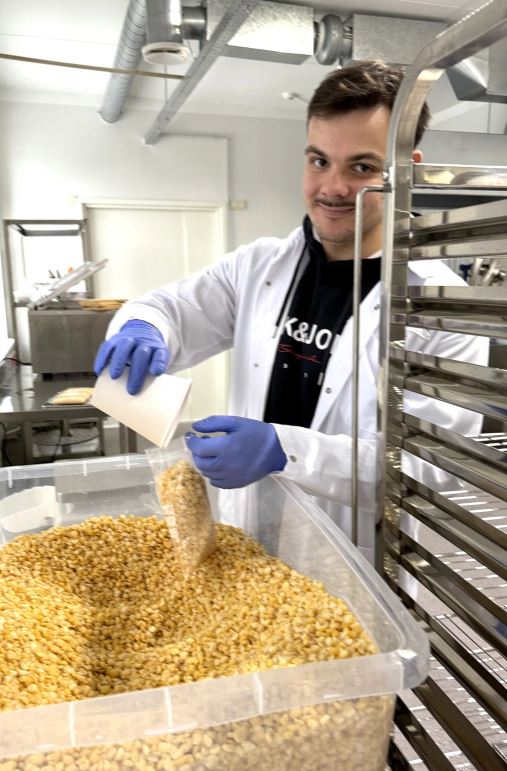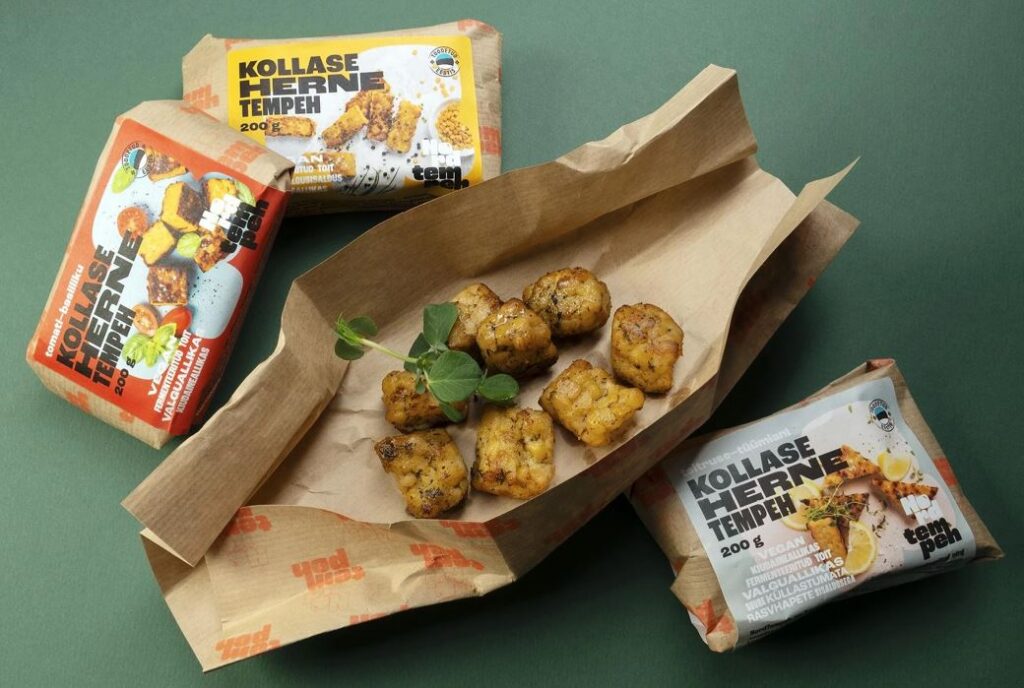Table of Contents
In a year-long PRIA supported project, a forward-thinking producer of clean-label plant-based foods NordicTempeh OÜ with TFTAK aimed to standardize and up-scale tempeh production using yellow peas, and to improve the product’s quality, microbial safety, and shelf-life.
Laying the Groundwork for Consistent Tempeh Production
Tempeh from yellow peas, already commercialized by NordicTempeh using a previously established protocol, had shown strong market potential. However, challenges such as raw material batch wise variability, microbial inconsistencies, and short shelf-life limited further scale-up and consumer trust. In addition to scientific and technical optimization, the project placed strong emphasis on sensory quality, because consumer acceptance depends also on taste, texture, and visual appeal. Sensory analysis and consumer testing were therefore embedded throughout the process to ensure the final products met market expectations.
This project sets out to refine and stabilize the existing production process using advanced scientific tools and a data-driven approach.

Scientific Tools and Work Packages in Action
The project was structured into three work packages:
- WP1 used metagenomics to map microbial communities during tempeh production.
- WP2 focused on process optimization, refining fermentation temperature, bag size, and quality control protocols to achieve consistency.
- WP3 tested alternative raw materials (soya beans, yellow peas, faba beans), performed sensory analysis, volatile compound profiling (GC-MS), and ran shelf-life trials to extend the refrigerated storage of the tempeh more than 30% – to up to 4 months.
The new standard operating procedures (SOPs) enabled semi-controlled fermentation at the client’s facility.
Overcoming Technical Barriers to Scale-Up
Initial batch inconsistencies, and lack of environmental control were significant hurdles. Through metagenomics, root causes were pinpointed, leading to facility upgrades and quality control protocols. Another challenge was maintaining stable fermentation conditions at the production facility, which initially led to inconsistent results. This was resolved by modifying the incubation environment, converting the entire room into a controlled incubator space. This upgrade eliminated issues such as overheating and poor aeration that had occurred with the previously used small-scale incubator.

Some Positive Surprises
What were memorable moments for our team? One observation was that soybeans performed well in terms of texture and taste, as expected from a traditional tempeh substrate. However, achieving comparable flavor and structural quality with yellow peas, despite their more challenging fermentation behavior, was a key success of the project.
Also memorable was witnessing the transformation of the client’s facility, where a once basic setup evolved into an environment capable of producing stable tempeh with improved sensory appeal. We were glad to support the Estonian company NordicTempeh OÜ in achieving such a positive transformation.
Validated Results for a Stronger Product
- Microbial control: Reliable identification and mitigation of spoilage organisms and their associated growth conditions and volatile compounds.
- Process optimization: Stable fermentation temperatures, optimized bag design, and improved SOPs.
- Ingredient innovation: Soya and yellow peas emerged as the best substrates for Nordic tempeh.
- Sensory and consumer validation: Sensory analysis confirmed that optimized conditions enhanced texture and flavor. Consumer trials validated product acceptability and freshness, supporting market readiness.
- Shelf-life extension: Increased refrigerated shelf life achieved under vacuum-sealed, steam-pasteurized conditions.
- Production readiness: Validated protocols enabled scale-up and market-ready prototypes.
These outcomes provide a science-backed foundation for sustainable tempeh production in Northern Europe. The teamwork bridged industrial application with scientific research, ensuring that protocols were feasible in real-world production.
Next Steps for Sustainable Tempeh Innovation
The insights from PRIA are guiding product diversification, with potential for multi-legume tempeh lines. NordicTempeh is now equipped to explore new consumer segments and regional branding opportunities. Further scientific publications are underway, and the protocols are being shared across innovation networks in Estonia and beyond.
This project was a journey of scientific learning, collaborative problem-solving, and real-world impact. For the TFTAK team, it was a chance to blend research with industry, delivering tangible improvements and reinforcing the capabilities of solid-state fermentation within TFTAK. For NordicTempeh, it was a transformational step in becoming a reliable producer of clean-label fermented foods in Europe.

This article was originally published on the webpage of TFTAK.
If this taste of food science has whetted your appetite, don’t push away the plate! Dig into our next article and read more about how Bacterial proteins can save frozen dough!
 Back
Back



